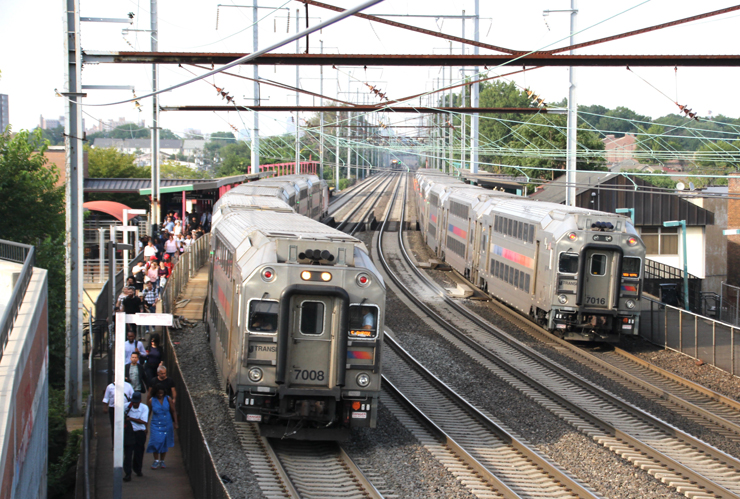
NEWARK, N.J. — NJ Transit is planning to spend more than $8 million to replace windows on its bilevel passenger cars to address complaints about reduced visibility, NJ.com reports.
While passengers often complain the windows are dirty, the problem is actually the use of a polycarbonate glazing which gradually clouds when exposed to ultraviolet rays, heat, and other factors, an agency spokesman told the news site. Those windows must meet Federal Railroad Administration standards to withstand impacts from projectiles or in case of a derailment.
The spokesman, Jim Smith, said NJ Transit has tried various methods to restore the windows and reached out to manufacturers for a solution without success.
So the solution will be to replace the windows on its 429 Bombardier bilevels, built between 2006 and 2013. Cost: $8 million plus labor.
“As we are aware of how important this is to the quality of our customers’ rail commute, we are working expeditiously to establish the most efficient replacement program and schedule, so work can begin as soon as possible,” Smith told NJ.com.














I’ve ridden on the pascack valley line recently and I have to say it’s pretty bad. Bi levels are the worst.
I remember water stuck between the windows on a dining car on the San Francisco Zephyr. The water would flow from one end of the window to the other depending on the train’s motion.
New Haven Railroad windows sloshed with water between the panes. No I’m not making it up. God’s honest truth.
Not only NH.
When I was driving (OTR), I would have to get the windshield replaced at about 350-400,000 miles as the glass became badly micro pitted. It was so bad that one had to stop when the sun would get low in front, as the glass became opaque.
Have to wonder. Most commercial airliners use cockpit windows thast are a sandwich of the stregth material and glass on either side. Stays clear and don’t scratch as long as proper glass care is used. Would those be more costly for NJT? Especially if replacement is required after a number of years.
I long for the double-pane clear glass windows with shades on passenger trains. One can view and photograph scenery without tint, scratches or opacity.
MBTA bilevels have had the same problem. A mix of coach mfrs but perhaps the same glazing supplier as in NJ.
When I ride a train I want to be able to see out the windows. Even when I go through the Green River valley on the Sounder in the Seattle area, I want to see what is going on though I have been in that valley hundreds of times. I do remember issues with Lexan, as I remember, it scratched easily when it was washed.
I don’t know what particular plastic formula they use for their glazing, but I remember “Lexan” having viewing problems fifty years ago, when glass was first deemed inappropriate for viewing the rocks flying at it in the Northeast Corridor.
Amtrak’s solution was simple: triple glazing: glass, poly, glass. That was probably 45 years ago.
Speaking of no scenery, try the Michigan Central line Detroit to Buffalo via St. Thomas, Ontario. Or Chicago to Champaign. That was two rides I remember from Amtrak’s Lexan days, 1975 and 1973 respectively. Couldn’t see out the window but nothing to see. But it can be disorienting to some people to be in motion with nothing to look at
I don’t know how much damage there is to the windows. But if they are opaque, then passengers are not even able to see station names and landmarks that they might use to know the location of the train.
I don’t think they’re opaque; it sounds like exactly the same problem as with car headlights – the polycarbonate becomes cloudy and needs to be treated. Surely the manufacturers would have been aware of the problem before building the cars, so I guess it was a cost-saving decision.
Why the hell do they need to see out the windows…is the scenery in New Jersey on your commute that beautiful?
What a strange comment. You feel passengers are not entitled to see out windows? I am sure you would be among the first to complain if it were to be true on your trips. Incidentally, the scenery along much of the NJ Transit system is quite lovely. I lived along the Gladstone branch for decades and there is lots to enjoy.
You need to be able to see where you are for ordinary mortals to know when they should be getting ready to get off. Works on transit lines too. For railfans you want to see equipment in yards, obscure and rare reporting marks on boxcars (Missouri-Illinois! Minneapolis & St. Louis!), junctions (there’s the Rahway Valley!), and other such things. I used to say you could reduce all railroading Out West to maybe a dozen slides, one or two deserts with cacti, a billiard table-flat wheat/corn field, a Colorado Rocky or two, maybe a mountain goat or a bear perhaps, a train along the Pacific Ocean and so on. No need to go west of Buffalo and Pittsburgh or Steubenville at most. I won’t even start on the need to NOT go south of the Mason-Dixon Line..